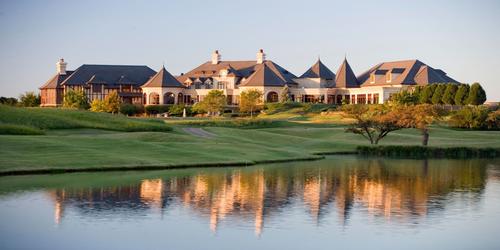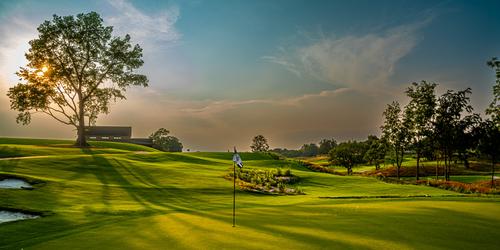
WINSTAR RESORT'S COURSES HIGHLIGHT NATIVE AMERICAN GOLF AND GAMING IN OKLAHOMA
By Steve Habel
THACKERVILLE, Oklahoma - Just north of most of Texas, the state of Oklahoma entices golfers from the Lone Star State to take a short trip across the Red River to gamble at their opulent Native American-owned casinos and play at their on-site or affiliated courses.
The Tribes have made their presence known in a big way with advertising during professional and college sporting events, marketing that emphasizes a "come-be-a-part-of-the-party" vibe that has hit the right note in the days after the shut-ins forced by COVID-19.
Any talk of golf and gaming in Oklahoma must start with the WinStar World Casino and Resort, set in southern Oklahoma just north the Red River on I-35. WinStar, owned and operated by the Chickasaw Nation of Oklahoma, is in Thackerville, about 80 miles from the Dallas-Fort Worth Metroplex.
But there are other options as well, as Oklahoma is, perhaps surprisingly to some, a wonderful place to play various styles of golf.
WinStar is as big as Texas to draw Texans
WinStar is billed as the "World's Biggest Casino" and is the home of two hotels, 24/7 gaming including over 100 table games and 55 poker tables, 19 restaurants, 12 bars, a theater for road shows and two wonderful golf courses and a state-of-the-art golf academy.
Both courses here - Redbud and Scissortail - were designed by D.A. Weibring and Steve Wolford, and between the two courses, there are some 20 acres of ponds and 54 acres of native area.
WinStar's courses boast generous fairways, silky smooth putting surfaces, and a fairway cut that extends around the perimeter of each green to present many recovery options.
Opened in 2006 as an 18-hole facility and built on 350 acres that was once a peanut farm and bordering woodlands, the daily-fee courses allow golfers to have fun and enjoy their rounds in a resort-type setting. The property expanded in 27 holes in 2011 with the debut of the South course and then 2017 to 36 holes when the Tribe unveiled the North course.
The East and West holes now form the Redbud course while and the North was combined with the South to make up the Scissortail course. Scissortail is the more difficult of the two courses at WinStar and has been ranked among the top 50 casino courses in the United States by Golfweek magazine.
Redbud sets the table with open routing
The Redbud course is WinStar's "resort" option, with a mostly open routing that winds its way through the Red River Valley and gives off an appropriate prairie vibe. Carded at 7,116 yards from its back set of five tees, Redbud is a playable thanks to its large fairways, some of the widest landing areas we've enjoyed in quite some time. But if you find the rough, this course can be very penal.
Redbud has a "links" look to it, and it's windswept, so not every approach shot is through the air. There are many bump-and-run options into the greens that make for an interesting thinking-man's round. Water comes into play on five holes but those hazards can be avoided fairly easily, and real trouble is found on only a handful of holes.
The course is highlighted by the par 3s on the back nine. The 14th is a 159-yard tester with a waste area and a pine tree just in front of the tees. Those features seemed to frame the hole well. The closer is the other par-3 on the back nine and Redbud's signature hole, with water covering the left side from tee to green and the bailout is right.
Redbud a well-balanced layout, with testing holes and others really getable. You can use the round to set the table for the more-challenging Scissortail or as a reprieve, of sorts, after a day at the tougher course.
Scissortail brings out, and asks for, the golfer's best
Scissortail is a classic design utilizing the natural topography of the property, with a variety of holes to keep the accomplished golfer on his toes and a routing that also allows for the beginner to finish the round with some satisfaction.
Scissortail is laid out through some relatively flat, forested terrain that creates an impression of golf in North Carolina. The back tees here are listed at 7,192 yards but play closer to 7,400 once if you take on the additional tees that have been added to several holes.
The greens are grassed with the Mini-Verde strain of ultra-dwarf Bermuda. Fairways and roughs are the hybrid TifSport Bermuda grass. The putting surfaces on the back nine are a bit larger with more contours than the front.
The round starts with a 557-yard, par 5 with trees lining both sides of the landing area. If you can get a good look at the green take a chance at getting home in two but stay right as water looms on the front left.
Scissortail's front-nine ends with a 553-yard, par-5 that plays downwind and, with a decent drive, lures you to go for this putting surface in two. But beware as water starts down the right side about 125 yards out and wraps around the green and bunkers and collection areas around the putting surface. The green is fashioned with a huge mound on the left and rolls from left to right toward the lake.
The back nine features gently bending, tree-lined par 4s and par 5s with a wooded ridge visible in the background. Water features come into play on several holes, particularly the wooded chute on the par-3 17th. The course's penultimate hole is a favorite of the staff, and is the course's signature offering, with water lurking on the left side of the green and measuring at 195 yards. The closing hole is a tough, 452-yard par 4 with multiple bunkers down the right side.
Scissortail a very fun and very fair test of golf that aesthetically and visually is not something you would expect to see and play in this part of Oklahoma.
Weibring and Wolford's goal was to create courses at WinStar that are user-friendly for those who need them to be yet challenging enough for higher-level players. It's hard to lose a ball here because there are no hidden shots or forced carries, and you can see where the ball lands.
But don't take WinStar for granted. Each hole offers its own risk-reward challenge and there is plenty of room to play but both courses are very much about positioning your shots, especially on the approaches.
More great options in the Sooner State
The other big player (see what I did there) for the North Texas market is the Choctaw Casino Resort in Durant, about 90 miles from Dallas. This place has 7,400 slot machines, more than 100 table games, a state-of-the-art poker room, 16 restaurants, and The District, which features bowling, an arcade, and six movie theatres. The lodging here is the brand-new Sky Tower, with 1,700 hotel rooms.
While Choctaw doesn't have an on-property golf course (one has been planned), the fabulous Randy Heckenkemper-designed Chickasaw Pointe Golf Course in Kingston is about 10 miles west of Durant on the other side of Lake Texoma and is a must-play when in the area. The best holes here are routed above the massive lake, where the wind plays havoc with your shots.
Further on up the road in Tulsa, the Hard Rock Casino beckons with its unique rock-and-roll themed casino and hotel and one of the best courses in Oklahoma, Cherokee Hills Golf Club. Designed by renowned architect and Oklahoma native Perry Maxwell in 1924 and renovated by Tripp Davis, Cherokee Hills Golf Club is a true challenge for the most accomplished golfer.
It's also inviting enough for the weekend player, with tree-lined fairways, dramatic elevation changes, demanding Bentgrass greens, natural rock outcroppings and babbling brooks.
Revised: 10/04/2023 - Article Viewed 5,566 Times
- View Course Profile
About: Steve Habel
 Steve Habel is a contributing editor for GolfTrips and its associated websites. A 26-year industry veteran, he regularly contributes to various regional, national and international golf publications and has played and written about more than 1,600 golf courses around the world.
Steve Habel is a contributing editor for GolfTrips and its associated websites. A 26-year industry veteran, he regularly contributes to various regional, national and international golf publications and has played and written about more than 1,600 golf courses around the world.
Habel is also senior editor for Horns Illustrated magazine, a publication focusing on University of Texas sports, as well the San Antonio Spurs beat writer for The Sports Xchange. He is a correspondent for the Austin American-Statesman and frequently files stories and features for The Associated Press and Preferred Lifestyle magazine.
Habel, who lives in the Austin, Texas area, has worked media coordinator for World Golf Hall of Fame player and golf architect Tom Kite as well as for renowned golf architects Roy Bechtol and Jeffrey D. Brauer.
He is a member of the Golf Writers Association of America, the Texas Golf Writers Association and the Football Writers Association of America.
Follow Steve Habel:
Contact Steve Habel:
GolfTrips.com - Contributor













